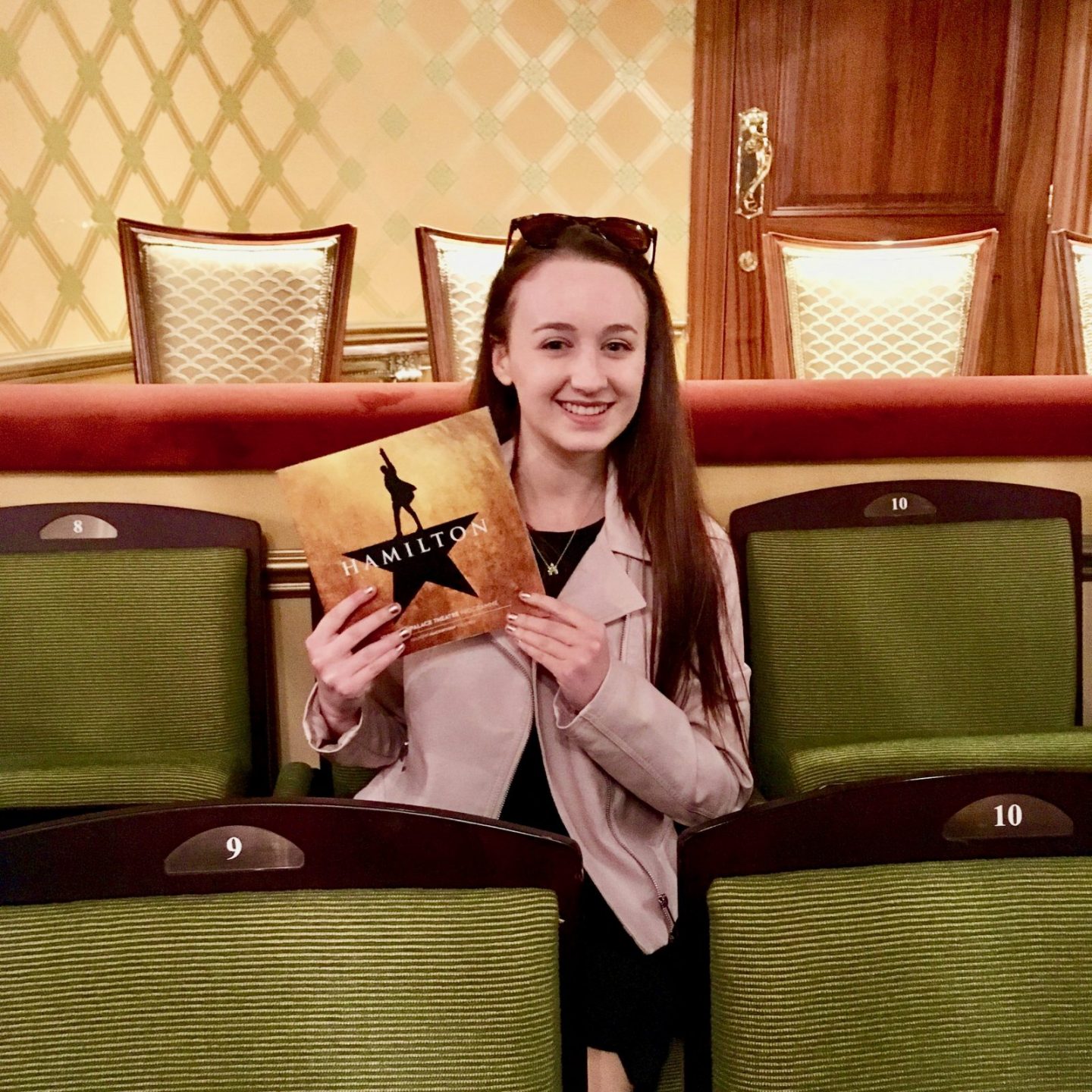
Expectations: 5/5
Reality: 5/5
Chronic illness friendly: 4.5/5 (keep scrolling for my review!)
When a show is so critically acclaimed and adored by so many, there’s always the worry that when you see it for yourself, you’re going to be disappointed. HOWEVER, I’m relieved to say that my ambitiously high expectations of Hamilton were most definitely met when I finally got to witness the spectacle for myself. I’m writing this review a mere 48 hours after seeing the show and it feels like I’m still processing what I saw- the emotional impact seems to be hitting me harder now, as I’m reflecting on the performance, than during the performance itself. And in my opinion, that’s what makes for a great musical: something that completely consumes you, even after you exit the theatre.
In brief, the show revolves around Alexander Hamilton, an orphaned immigrant from the West Indies, who rises to power as one of the founding fathers of America throughout the Revolutionary War. The story follows the controversy he sparks at every level of his personal and professional life, and how his own aggressive hunger for success led to his untimely death, in duel with his once friend, Aaron Burr.
I’m sure it goes without saying that I found Hamilton completely wonderful: a triumph for the cast and creative team that deserves every single ounce of critical acclaim and public adoration it received. On a scale of 0-10 for emotional impact level, with 10 being Pippa trying to contain a complete sentimental meltdown whilst listening to the soundtrack on the train home, it’s a solid 11.

For me personally, it was the jump from religiously listening to the Original Broadway Cast recording to seeing it translated on stage that really made the experience momentous. The biggest difference in my eyes was the depiction of Aaron Burr on stage: in comparison to simply following events on the soundtrack, the on-stage Burr appeared much more three-dimensional, more of a grey-area character in terms of righteousness and innocence. I cannot express how much I enjoyed Giles Terera as Aaron Burr: he gave the character the complexity he warrants, but in such a insightful way. His performance of Wait For It was one of those on-stage moments that you immediately know will stay with you for the rest of your life.
It was a joy to see alternate Alexander Hamilton, Ash Hunter, really do justice to the narcissistic yet mesmerising nature of Hamilton that the whole production hinges upon. Miriam-Teak Lee was an outstanding understudy Angelica, with the Satisfied number being one of my biggest stand-out moments from the show. I was surprised at how impactful I found One Last Time, being one of the lesser known songs to me beforehand, which speaks volumes about the incredible performance of Obioma Ugoala as George Washington. And of course, we can’t not talk about Michael Jibson as King George. In only a total of seven minutes on stage throughout the whole production, he had the entire audience in the palm of his hand: to have a stage presence so magnetic that you only have to passively sit on a chair stage-right and yet still know that the audience’s eyes are unable to leave you, to see what you do next? That’s a sign of real talent, right there.
And we can’t discount the ensemble, either. If you’ve read my reviews before, you’ll know that I adore a strong dance element in musicals, and Hamilton didn’t disappoint. Andy Blankenbuehler’s original choreography, facilitated by resident choreographer Carrie-Anne Ingrouille, was executed beautifully by the talented ensemble of dancers. The movement was so satisfyingly contemporary: hip-hop fused with jazz funk elements, that gave a glimpse into what I hope may become a turning point for more innovative, risky theatre choreography in years to come. From the staged dance breaks to the use of dancers as physical theatre props, such as the travelling bullet during the duels, the choreography definitely enhanced the unrivalled originality of the production as a whole. And that’s before you take the majestic King George’s sassy sashaying down the stairs into account.

One thing that was apparent throughout the show was that the staging had to be absolutely spot on. The rotating floor used on the stage made for an absolutely amazing visual effect in countless scenes, but I can only imagine how tricky it must have been for the cast and crew to perfect. There would be dancers performing in one spot on the floor as it turned, who would need to end up in exactly the right position to move straight into choreographed sequences in line. It was so gratifying to watch each of the cast absolutely nail these arrangements, and the floor was such a good move on the part of the production team: again, it was the staging of Satisfied which really highlighted how this could be used to keep the audience in the loop with Angelica’s point of view.
And finally, we have to talk about the music and lyrics by Lin-Manual Miranda: the single person responsible for creating this entire phenomenon. The songs will hook you from the first time you listen to them, but even after you’ve listened two or three (or twenty) times, I guarantee the wittiness of the lyrics will never go unnoticed or unappreciated. There are so many killer one-liners in there, alongside insightful reflections that were created to reflect life back then, ring true in this day and age, and, in my opinion, will remain timeless in years to come. From haunting soliloquies such as Hamilton’s parting words in The World Was Wide Enough, to the irresistibly catchy The Room Where It Happens, to a freaking rap showdown complete with mic drops in Cabinet Battle #1 and #2, Miranda really has created something magnificent.
The result of all these things is a production that deserves to be celebrated: something that’s iconic in every single way. Above all, I felt an overwhelming sense of relief that the performance fulfilled my expectations, and I’m sure I’m not alone in this: sitting in my seat, I could feel the entire audience around me willing this to be something special. Hamilton truly is a work of art: an outstanding musical that will without a doubt go straight into the history books. I’m so pleased that I got to be in The Room Where It Happens (had to be done, I’m not sorry.) and experience it for myself, and I urge all of you to do the same. I can guarantee you won’t be disappointed.

Chronic Illness Friendly Review
This was my first trip to the Victoria Palace, and before I get to my overall positive review, I have to get something significantly less positive out of the way. I was really disappointed to find out that at the time of writing, all of the accessible seats in the Victoria Palace are restricted view: no accessible seat has a full view of the stage. Although the view from my seat at the back of the stalls wasn’t too disturbed, only cutting off marginal parts of the show stage left, I was really disappointed with the flippant attitude of Delfont Mackintosh Theatres when I raised this with them. As the view was only partially restricted, and I accept this, they didn’t seem to understand why it was an issue that there was no option for full-time wheelchair users to have a full view of the stage. I feel this is a real step backwards for accessible theatre and given that the Victoria Palace has just undergone massive refurbishment, I do feel angry and disappointed that this issue wasn’t given higher priority. My comments have been passed on to higher up in the organisation, but whether or not anything will come out it, I’m not sure.
However, in complete contrast, my experience of attending the show itself as a chronically ill person was absolutely brilliant. Upon our arrival, we were assigned and introduced to a dedicated Access Host: a really lovely girl called Charlotte. She was our point of contact throughout the entire show: she took us around to the accessible entrance, showed us where all the facilities were, and explained that if we’d like to order drinks at the interval, she would bring them to us so we could avoid the crowds at the bar. As the merchandise stall was down a flight of stairs, she was also armed with a document with all the items and prices listed, and would have gone and fetched these for us if we’d chosen to purchase anything.
Charlotte came to check on us before the show, during the interval and afterwards, and I thought it was such a brilliant way of doing things: having that point of contact and level of assistance made us feel completely at ease, and took away a good deal of the hassle that can come from using a wheelchair in the theatre. The fact that she had introduced herself by name and chatted with us personally also had the benefit of making the assistance feel less *clinical* (for want of a better word), and much more friendly. I’d be interested to know if anybody had experienced this level of assistance in any other theatres: I couldn’t recommend it enough. So in that respect, Delfont Mackintosh did partially redeem itself in my eyes. An online friend of mine, Nina from brainkittens.com, posted a detailed access review of the venue which I’d also recommend reading: it’s good to see that improvements have been made over the past couple of months, and I can only hope that speaking out about these things helps to facilitate ever-improving accessibility in the industry.

In terms of the content of the show, I’d say that generally speaking, it was pretty safe and suitable for chronic illness, much more so than I was expecting: no strobe lighting or overly loud/jumpy sound effects, even during battle scenes. The Yorktown number was the only one which was possibly borderline, with more abrupt and vigorous special effects in sound and lighting.
There are two main things associated with the content of the production that I’d take into consideration, if you have a chronic illness. The first is how you are with hip-hop music: having that heavier bass-line and rhythmic beats can sometimes feel a bit more ‘intense’ on noise sensitive brains. I’d recommend giving the soundtrack a listen and seeing how you get on: in my opinion, the sound and music during the show is no more intense than it comes across on the recording.
The second and final thing to maybe have a think about refers to the cognitive exertion required to follow parts of the story: with the show being comprised almost entirely of song and rap, you do need to have your brain in gear to be able to follow and appreciate the story, if you don’t know it beforehand. If you feel this may be an issue for you, I’d strongly recommend familiarising yourself with the synopsis beforehand, and once again, listening to the soundtrack.
Basically, the take home message is that if you’re undecided about whether this production is suitable for you, just listen to the soundtrack and see how you get on. But please don’t hold me liable if you happen to fall in love with it and decide to see the show regardless. Sometimes these things are worth it, and believe me, this one is worth it a thousand times over.
Have you seen Hamilton yet? How did you find it? I’d LOVE to know what your highlights were!





